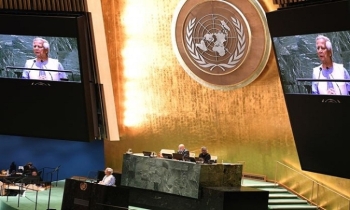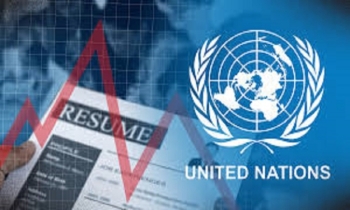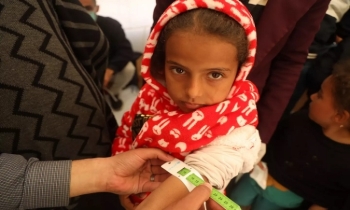A leap forward on cross-border payments
Tobias Adrian and Kristalina Georgieva, IMFBlog || BusinessInsider

Logo of International Monetary Fund
When paying for coffee, we swipe, tap, wave, and soon may wink—a quick and painless exchange of coffee for money. But when paying for imports or sending remittances, we often fill-out forms, wait for days, and pay—too much.
Progress to improve cross-border payments has been slow, but is just about to take off. That is how history evolves—one small step at a time, until it suddenly leaps forward. The confluence of new technologies and renewed determination among policymakers are making significant improvements possible. Meanwhile, households and firms have come to expect (and demand) better services.
The stakes are high. Changes to cross-border payments have a bearing on the stability of the international monetary system, on financial inclusion, and on the efficiency of trade and financial markets. And reforms may unlock innovation and much needed growth, particularly following the COVID-19 crisis. But a leap forward will only be possible if the world works together.
And it has—in an exceptional manner. A roadmap to decisively enhance cross-border payments, led by the Financial Stability Board along with a wide set of institutions including the IMF, has just been endorsed by the G20. This is not one more report, but a set of concrete reforms, practical steps, and milestones that specific institutions will be held accountable to implement. Meanwhile, the IMF just published a staff paper on the macro-financial implications of new forms of digital money available across borders. Together, these papers provide a clear path forward, mindful of the challenges that lie ahead. If implemented, reforms have the potential to be transformative by making cross-border payments cheaper, faster, more transparent, and more widely accessible.
The next step
While international cooperation has gotten us this far, it will be all the more important to implement, and potentially even surpass, the G20 roadmap. Specifically, we need cooperation in four broad areas to ensure improvements to cross-border payments are effective, sustainable, safe, and equitable.
First, solutions to cross-border payments must be designed and pursued with all countries in mind. Countries differ considerably in implementation capacity, existing infrastructure, and financial sector development. And with different countries come different users. These cover large companies operating in less liquid markets, cost-conscious small- and medium-sized enterprises, and the 1 billion people sending and receiving remittances (which at an average cost of 7 percent are still double the target set by United Nations’ Development Goals).
The G20 roadmap is appropriately flexible given this diversity of needs. Some solutions involve improvements to existing systems, such as devising trustworthy digital identities essential for financial inclusion. Others are more exploratory and consider a world in which we can freely trade digital currencies across borders, much like we send emails today. It is essential that all these solutions continue to be pursued, discussed, tested, and some discarded—with an open mind.
Second, cooperation is essential to overcome countries’ “inaction bias,” and ensure solutions are widely applicable. A simple example is the operating hours of countries’ settlement systems: only when two countries extend hours so they overlap can cross-border transactions be settled in real time. No country will want to act alone. Even then, the two systems must talk to each other. But interoperability is not a given. It requires basic technological, design, legal, and regulatory standards. Cooperation will ensure these satisfy the needs of a wide community, which the IMF can help congregate.
Third, cooperation is critical to build solutions that benefit from the experience and perspective of all relevant actors—such as central banks, regulators, finance ministries, anti-trust agencies, data protection agencies, and international organizations. The Financial Stability Board report was exemplary in this respect. Moreover, the public and private sectors must cooperate, recognizing each other’s strengths: private companies to innovate and interact with users, and the public sector to regulate, supervise, and ultimately provide trust to the system. Where possible, public-private solutions should be explored.
Lastly, cooperation means recognizing the macro-financial effects that one country’s policies can have on others. For instance, new forms of digital money issued in major reserve currencies could improve domestic as well as cross-border payments. But they could also induce citizens abroad to forego their domestic currency, especially in countries with high inflation and volatile exchange rates. And digital money could potentially facilitate bank runs out of these countries. Meanwhile, source countries could see more volatile capital inflows and central bank balance sheets. Moreover, it is unclear if capital account restrictions, which many countries adopt, can be redesigned so they are not circumvented by digital money. Finally, the use of digital money could raise significant risks to financial integrity. These and other scenarios are detailed in our new paper.
Global links
Monetary policy, financial stability, capital flows, international reserves—all could be affected by transformations in cross-border payments, with implications for the international monetary system. The IMF’s founding members understood this link, which to some extent lies behind the vision to “assist in the establishment of a multilateral system of payments,” as stated in the Articles of Agreement.
Today, the IMF continues to play an active role in this space, working hand-in-hand with other international organizations. Our near-universal membership can help ensure that the digital revolution benefits people in all countries. And our global perspective can help recognize spillover effects, as well as provide a common forum to address the underlying policy dilemmas. Let’s engage on this promising path together.
The article first appeared in IMFBlog.
























